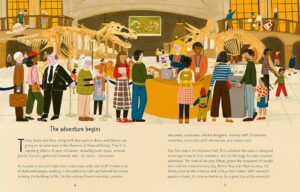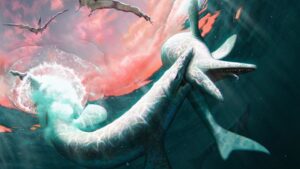What Dinosaur Is Littlefoot
In the beloved film 'The Land Before Time,' Littlefoot embarks on a journey that has captivated audiences for decades. As the young protagonist, Littlefoot's species has often been a topic of fascination among fans and dinosaur enthusiasts alike.
He's widely recognized as an Apatosaurus, a choice that reflects both the film's creative direction and the paleontological knowledge of the time.
However, the decision to classify Littlefoot as such opens up a broader conversation about how dinosaurs are represented in popular media and the impact of these portrayals on public understanding of prehistoric life. This intersection between fiction and science offers a unique perspective on our relationship with these ancient creatures, suggesting there's much more to explore about the gentle giant at the heart of this timeless story.
Key Takeaways
- Littlefoot is depicted as an Apatosaurus, a massive sauropod from the Late Jurassic period.
- The character showcases the complexity of dinosaur evolution and lifestyle.
- Apatosaurus' diet and habitat preferences are reflected in Littlefoot's adventures.
- Littlefoot's depiction in the series educates viewers on Jurassic world science.
Unveiling Littlefoot's Species
In the realm of paleontology, Littlefoot is identified as an Apatosaurus, a genus of large sauropod dinosaurs that roamed North America during the Late Jurassic period. This distinction places Littlefoot among the most iconic creatures that have captivated the scientific community and the public's imagination.
Apatosaurus, characterized by its massive body, long neck, and whip-like tail, represents a marvel of prehistoric life, showcasing the diversity and complexity of dinosaur evolution. Researchers have meticulously analyzed fossil records to understand the lifestyle, diet, and habitat preferences of these behemoths.
Their findings suggest that Apatosaurus likely grazed on high vegetation, utilizing its towering neck to reach food sources inaccessible to other species. This analytical approach underscores the freedom inherent in scientific inquiry, allowing for a nuanced appreciation of Earth's ancient inhabitants.
The Land Before Time Legacy
The Land Before Time series has significantly influenced cultural perceptions of dinosaurs, embedding itself into the global consciousness. Through its memorable characters, the franchise facilitates a nuanced exploration of themes such as friendship, survival, and adventure.
This analytical focus reveals the series' role in shaping public understanding of prehistoric life, beyond mere entertainment.
Series Cultural Impact
Littlefoot's adventures in 'The Land Before Time' series have significantly influenced children's media by showcasing themes of friendship, perseverance, and diversity. This influence is quantifiable across several dimensions:
- Educational Outreach: The series promotes an understanding of complex emotional and social issues, providing a platform for parents and educators to discuss these topics with children in an accessible manner.
- Inspirational Content: It inspires viewers to embrace differences and work collectively towards common goals, reflecting an ethos of inclusivity and cooperation.
- Cultural Longevity: The enduring popularity of 'The Land Before Time' series underscores its impact on generations of viewers, cementing its legacy as a seminal work that transcends cultural and temporal boundaries, fostering a sense of freedom and exploration among its audience.
Memorable Characters Exploration
Exploring the memorable characters of 'The Land Before Time' series reveals a rich tapestry of personalities that contribute significantly to the narrative's depth and its educational impact on audiences. Littlefoot, the Apatosaurus protagonist, embodies resilience and leadership, guiding his diverse group of friends through perilous landscapes in a quest for survival.
This character ensemble, including Cera the Triceratops, Ducky the Saurolophus, Petrie the Pteranodon, and Spike the Stegosaurus, represents a microcosm of societal cooperation and emotional intelligence. Their interactions, challenges, and growth highlight the importance of empathy, understanding, and collective problem-solving.
Through these characters, the series provides a platform for exploring complex themes such as loss, friendship, and perseverance, thereby offering viewers, particularly young ones, valuable life lessons within an engaging prehistoric setting.
Paleontological Inspirations
The character Littlefoot draws his lineage from specific paleontological inspirations, with his species origins rooted in the Apatosaurus genus. This section compares Littlefoot's fictional representation with real-life dinosaur physiology and behavior, highlighting both accuracies and artistic liberties.
Such analysis reveals the depth of research animators undertook, while also showcasing the inevitable gaps between cinematic portrayal and scientific evidence.
Littlefoot's Species Origins
Drawing inspiration from the real-world paleontological discoveries, Littlefoot's character design and species classification mirror those of the Apatosaurus, a genus of herbivorous sauropod dinosaurs that lived during the late Jurassic period. This link between Littlefoot and the Apatosaurus isn't coincidental but deeply rooted in scientific research and paleontological evidence.
- Distinctive Features: The Apatosaurus was known for its massive size, long neck, and whip-like tail, characteristics that are prominently featured in Littlefoot's design.
- Social Behavior: Research suggests that Apatosaurus lived in herds, a trait reflected in Littlefoot's interactions with other dinosaurs.
- Diet: As herbivores, Apatosaurus primarily fed on plants, paralleling Littlefoot's dietary habits depicted throughout the series.
This scientific foundation ensures that Littlefoot's portrayal not only entertains but educates, offering a window into the Jurassic world.
Real-Life Dinosaur Comparisons
While Littlefoot's character vividly embodies the attributes of the Apatosaurus, his portrayal also opens a broader dialogue with the paleontological community about the accuracy and creative interpretation of dinosaur behavior and physiology. Real-life comparisons reveal that the Apatosaurus, a genus that thrived in the late Jurassic period, exhibited distinct features such as a long neck used for foraging and a massive body that supported its herbivorous diet.
However, depictions in popular media, including Littlefoot's character, often imbue these ancient creatures with anthropomorphized behaviors and emotional complexity not directly evidenced by fossil records. Such portrayals stimulate public interest but also challenge scientists to bridge the gap between factual accuracy and the imaginative freedom that characterizes artistic representations of dinosaurs.
Apatosaurus: The Gentle Giant
Apatosaurus, often celebrated for its immense size, showcases the evolutionary marvels of the Jurassic period through its robust skeletal structure and elongated neck. This dinosaur, epitomizing the term 'gentle giant,' lived approximately 150 million years ago and has since fascinated paleontologists and the public alike. Detailed analysis reveals several noteworthy characteristics:
- Size and Scale: Adults could reach lengths of up to 75 feet, making Apatosaurus one of the largest land animals to have ever existed.
- Dietary Habits: It was a herbivore, using its long neck to reach high vegetation, an adaptation critical for survival in the dense forests of the Jurassic.
- Social Behavior: Evidence suggests that Apatosaurus might've lived in herds, offering protection and fostering a social environment.
These attributes underscore its significance in understanding dinosaur ecology and behavior.
Character Design and Development
Shifting focus to the realm of character design and development, it's essential to examine how the Apatosaurus' distinctive features have influenced its portrayal in popular media. Designers meticulously select physical traits—long necks, robust bodies, and gentle eyes—to evoke empathy and connect with audiences.
This process involves a deep understanding of paleontological findings, translating into character traits that resonate on an emotional level. The development phase iterates over these designs, refining them to balance scientific accuracy with relatable, anthropomorphic qualities.
This meticulous attention to detail ensures the character's visual appeal while fostering a sense of familiarity and freedom among viewers. Thus, character design and development for creatures like Littlefoot serves as a bridge, connecting the realms of science and imagination seamlessly.
Littlefoot's Evolution in Film
Throughout the film series, Littlefoot's character has consistently evolved, reflecting advancements in animation technology and deepening understandings of dinosaur behavior. The evolution of Littlefoot can be detailed as follows:
- Enhanced Realism: Initially, Littlefoot was depicted with a simplistic design. With time, animators incorporated more detailed textures and lifelike movements, mirroring the latest paleontological discoveries.
- Behavioral Accuracy: Early films portrayed Littlefoot with generalized dinosaur behaviors. Later entries, however, showcased specific behaviors aligned with the Apatosaurus species, such as social habits and feeding techniques, demonstrating a commitment to scientific accuracy.
- Emotional Depth: Littlefoot's emotional range expanded significantly, from basic expressions of happiness and fear to more complex emotions like empathy and determination, paralleling the character's growth and the audience's expanding expectations for animated protagonists.
Comparing Fiction With Science
While Littlefoot's portrayal in the film series charms audiences, it also invites a critical examination of how closely fiction aligns with scientific evidence regarding Apatosaurus behavior and physiology.
Paleontological findings suggest Apatosaurus, the genus Littlefoot represents, showcased significantly different traits than those depicted. For instance, the film anthropomorphizes Littlefoot, attributing to him a range of emotions and complex social behaviors not directly evidenced in fossil records.
Scientifically, Apatosaurus likely lived in herds, a fact the series accurately portrays, yet the intricate family dynamics and friendships depicted stretch beyond empirical support. Additionally, the character's physical agility contrasts with the understood lumbering nature of such massive sauropods.
This juxtaposition highlights a creative liberty filmmakers often take, prioritizing narrative engagement over strict adherence to paleontological accuracy.
Cultural Impact of Littlefoot
Exploring the portrayal of Littlefoot in the film series reveals a broader cultural phenomenon, where this character has significantly influenced public perceptions of dinosaurs beyond the realms of entertainment. Littlefoot's journey not only entertains but educates, subtly weaving paleontological facts into its narrative fabric. This has led to:
- An increased interest in paleontology among children, inspiring future generations of scientists.
- The personification of dinosaurs, fostering a deeper empathy and connection with these ancient creatures.
- A surge in dinosaur-themed media and merchandise, indicating Littlefoot's lasting impact on consumer culture.
Through these contributions, Littlefoot transcends his animated existence, becoming a catalyst for educational curiosity and a symbol of the enduring fascination with dinosaurs. This character's legacy underscores the power of storytelling in shaping public understanding and interest in scientific fields.
Future of Dinosaur Research
Advancements in technology and methodology are poised to revolutionize the field of dinosaur research, promising unprecedented insights into their lives and environments.
Techniques such as high-resolution imaging and computer modeling enable scientists to virtually reconstruct dinosaur behavior and physiology in detail previously unimaginable.
Genetic analysis, though its application is limited to relatively recent specimens, offers potential glimpses into dinosaur lineage and evolution.
Paleobotany, the study of ancient plants, further illuminates the ecosystems that supported these magnificent creatures, providing a more comprehensive understanding of their survival and extinction dynamics.
As researchers harness these innovative tools, they're not just uncovering the past; they're piecing together a puzzle that bridges millions of years, connecting us with the ancient architects of our planet's biological diversity.
Conclusion
In conclusion, Littlefoot, the cherished protagonist from 'The Land Before Time,' embodies the majestic Apatosaurus, a species that roamed the ancient landscapes with grace.
Through meticulous character design and evolutionary depiction in film, Littlefoot has bridged the gap between scientific inquiry and cultural enchantment.
His journey not only illuminates the wonders of prehistoric life but also ignites a passion for the mysteries that still lie beneath the earth's surface, awaiting discovery.





